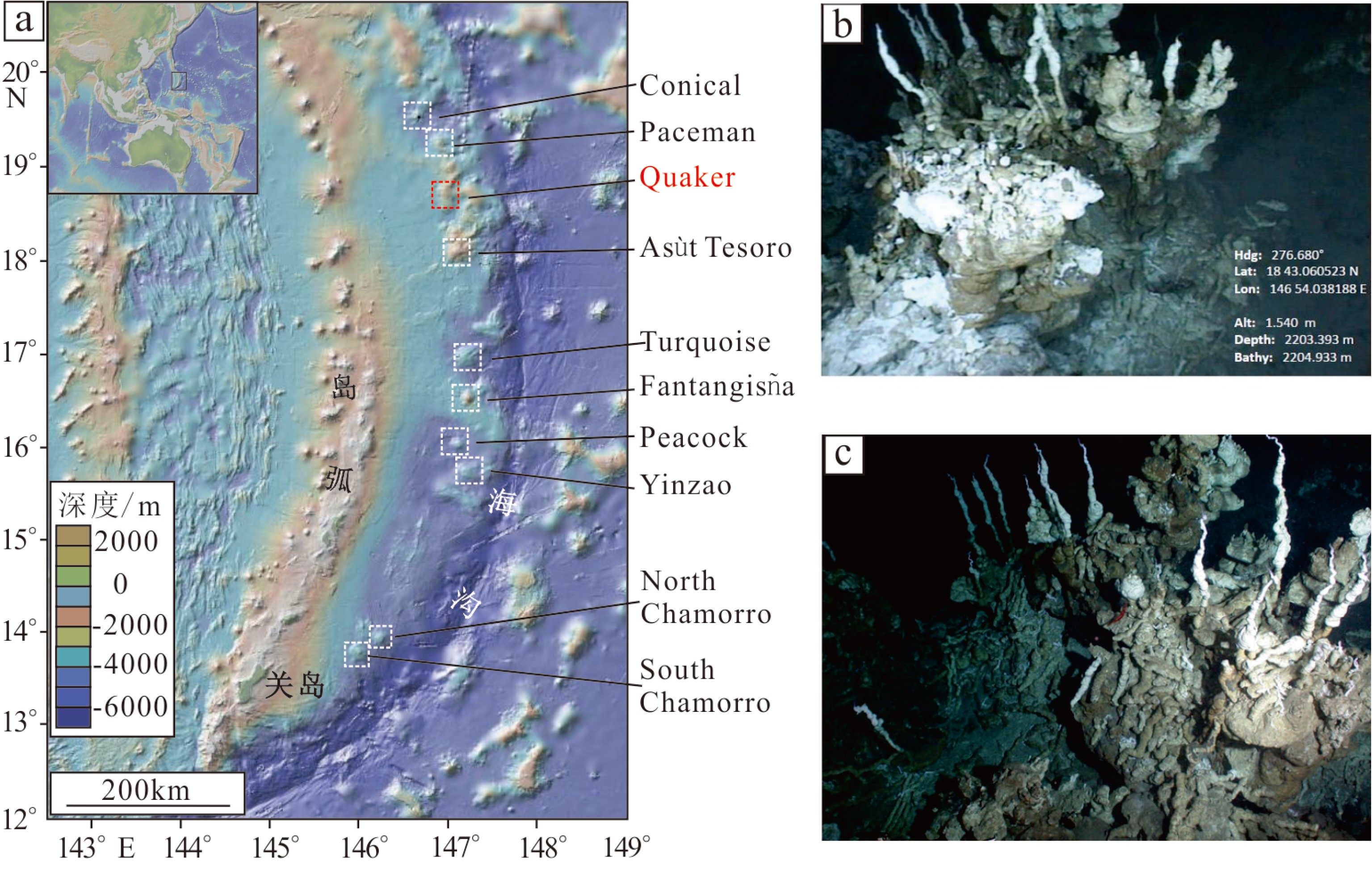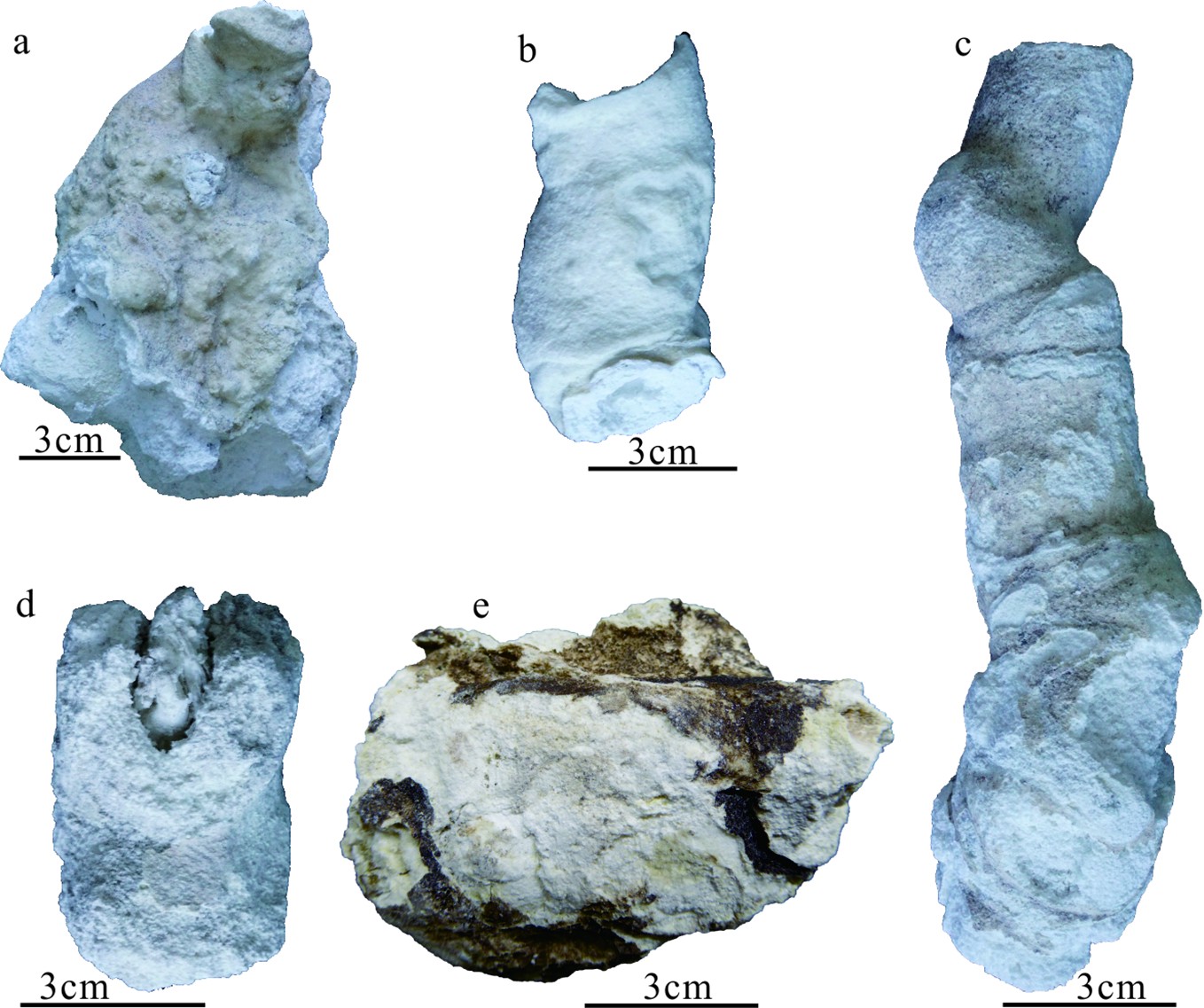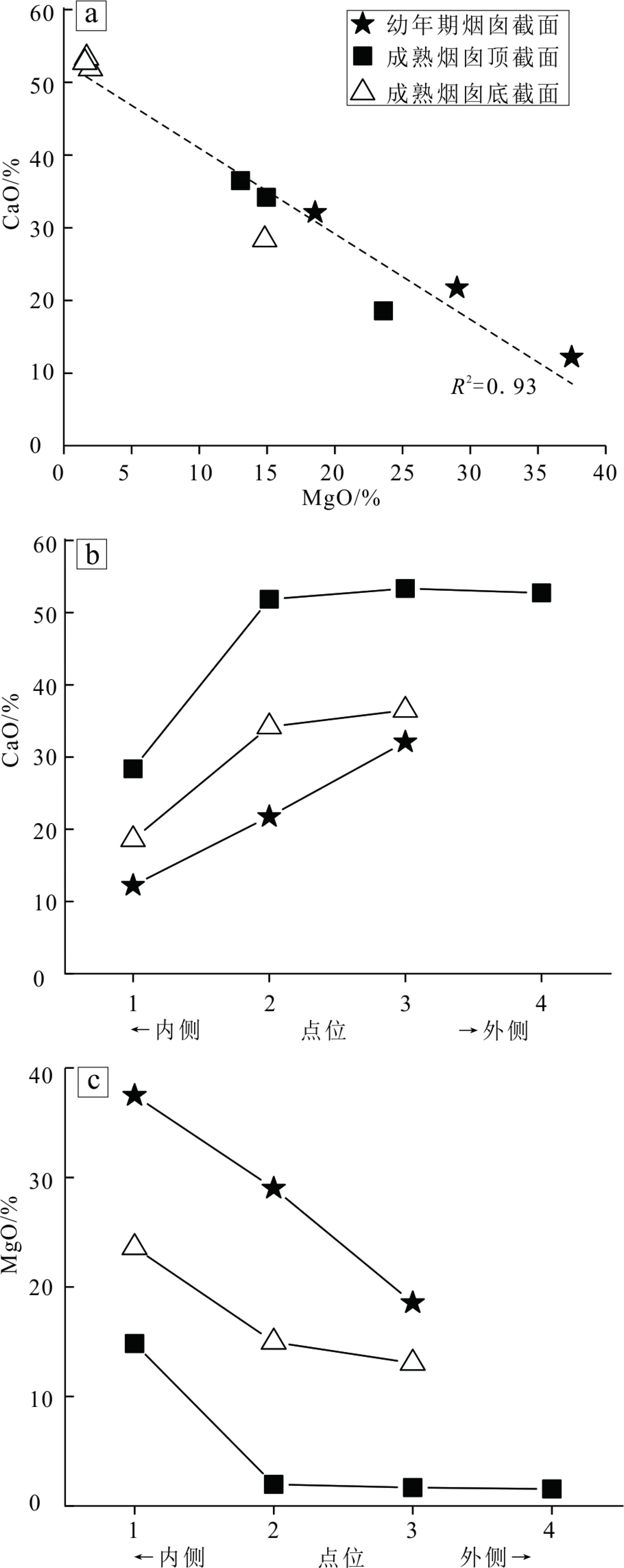Formation model of authigenic chimneys on the Quaker serpentinite mud volcano in the Mariana forearc
-
摘要: 马里亚纳弧前蛇纹岩泥火山顶发育烟囱状自生沉积,由海底低温碱性流体渗漏形成,它对示踪蛇纹石化流体渗漏有重要意义,但烟囱生长模式仍未明确。本文选取马里亚纳弧前Quaker蛇纹岩泥火山烟囱状自生碳酸盐岩,进行岩石学、矿物学和元素地球化学研究,查明不同生长阶段烟囱元素组成、矿物类型及演化规律,提出烟囱生长模式。幼年烟囱具有高MgO(18.5%~37.5%)和低CaO含量(12.2%~32.1%),由方解石(52.0%~77.6%)及以水镁石为主的富镁碱性矿物组成;成熟烟囱MgO含量显著降低(1.5%~23.6%),CaO含量显著升高(18.6%~53.3%),除发育方解石(59.8%)和少量富镁矿物外,还发育文石(23.4%);死亡烟囱不含富镁矿物,文石含量最高(33.2%),显微镜和扫描电镜下均观察到文石交代富镁矿物。不同类型烟囱间元素和矿物组成差异以及岩石学特征,说明渗漏流体导致方解石和水镁石沉淀,而文石为交代产物,在烟囱成熟过程中亚稳定的水镁石最终被文石交代,文石及CaO和MgO含量可指示烟囱的成熟程度。同一烟囱横截面由内向外微区样品的MgO含量依次降低,CaO含量依次升高,说明烟囱内侧较新,外侧较老,烟囱由外向内生长。同一烟囱下部横截面MgO含量低于上部横截面,CaO含量则相反,说明下部先形成,指示烟囱自下而上生长。Abstract: Authigenic chimneys, found at the top of serpentinite mud volcanos in the Mariana forearc, are induced by the seepage of low temperature and alkaline fluids. They are critical significant to trace the eruption of serpentinization fluids. However, few is known with regards to the formation mechanism of these chimneys. In this paper, detailed investigations are carried out on the petrology, mineralogy, and major elemental geochemistry of the chimneys collected from the Quaker serpentinite mud volcano in the Mariana forearc region so as to explore the formation model of these authigenic chimneys. Base on the mineral and elemental compositions, as well as neomorphic processes, three types of chimneys are identified. It is found that infancy chimneys are high in MgO (18.5%~37.5%) and low in CaO contents (12.2%~32.1%), and mineralogically composed of calcite (52.0%~77.6%) and magnesium-rich alkaline minerals, such as brucite, hydromagnesite, and hydrotalcite, while the mature chimneys are characterized by reduced MgO contents (1.5%~23.6%) and enhanced CaO contents (18.6%~53.3%), and mineralogically composed of calcite (59.8%), magnesium-rich minerals and aragonite (23.4%). Dead chimneys have the highest aragonite content (33.2%), but do not contain any magnesium-rich minerals. In addition, microscopic observation results have revealed the precursory magnesium-rich alkaline minerals replaced by aragonite. The variations of elemental and mineral compositions among different types of chimneys, and their petrological characteristics suggest that the fluid seepage induced calcite and brucite precipitation, while aragonite represents a replaced phase of brucite. Brucite occurrences indicate newly formed fabrics, while aragonite reflects an old precursory mineral. Micro-drilled samples from the same chimney cross section show successively decrease of MgO content and increase of CaO content from inner to outer, suggesting that the outer texture is older than the inner. The top of a chimney displays higher MgO and lower CaO contents than the bottom, indicating that the top is relatively younger.
-
Keywords:
- authigenic chimney /
- petrology /
- mineralogy /
- formation model /
- serpentinite mud volcano /
- Mariana forearc
-
随着复杂油气藏勘探精度的提高,精细的地震属性反演、油气储层的定量描述都需要高分辨率的地震资料。而地层的吸收衰减作用是影响地震资料分辨率的一个主要因素[1],从而导致了有效反射波频带变窄,相位产生畸变,分辨率和信噪比降低,从而影响了地震资料的成像精度。Q补偿作为一种确定性的处理技术[2],不仅可以补偿地震反射信号的频率和振幅衰减,同时能改善地震子波的相位特性,使中深层的高频部分得到加强,频谱被拓宽,从而有效提高地震资料的质量。
反Q滤波补偿方面也有许多学者进行了研究,基本可以分为3类:用级数展开作近似高频补偿的反Q滤波、基于波场延拓的反Q 滤波和其他反Q滤波方法。最早Hale提出Futterman模型进行反Q滤波的方法[3],该方法基于预测误差滤波分析迭代求出Q值,然后进行Q补偿,其缺点是计算量大。Bickel和Natarajan根据复函数分析技术提出一种反Q滤波方法,此方法基于平面波假设,通过复数对平面波传播进行描述,从而得到时变的Q补偿[4]。Hargreaves和Calvert根据常Q模型得到相位Q补偿方法[5],其做法是通过波场外推来计算常Q模型,从而对相位进行补偿,缺点是未考虑振幅的影响。Bano利用常Q模型发展到层常Q值模型的相位Q补偿方法,优势在于补偿结果能稳定地改善相位的畸变,而且准确性比较高,但同样忽略了振幅的影响[6]。WANG基于等间隔形式的Q模型提出一种稳定有效的反Q滤波方法,此方法以波场延拓理论为基础,并对Q值求取的抗噪性和稳定性进行深入讨论,并不断完善,形成了最常用的反Q滤波算法[7-9]。严红勇和刘洋在WANG方法的基础上,发展成沿射线路径进行波场延拓从而进行Q补偿的方法,主要是针对多分量资料进行处理[10]。刘财等提出基于频率域分时窗吸收补偿的反Q滤波方法[11];Zhang和Ulrych在反Q滤波过程中引入了最小二乘方法和Bayasian原理,从而弥补了Q求取的不稳定性,并在实际数据中得到了很好的效果[12];王本锋等结合反演的思想正则化方法提出了一种新的补偿方法,该方法基于波场延拓的正Q滤波方程,对有效频带内的频率分量进行分析,提高了计算效率,补偿结果稳定高效[13]。叶秋焱利用广义S变换求取时频域表层Q值的方法,通过表层Q值与井控深层Q值建立综合Q体,从而对地震数据进行Q补偿[14]。
虽然地层Q值补偿方法的理论和算法比较成熟,但是在实际地震资料处理应用中一直存在其稳定性和抗噪性不足的问题[15-19],尤其是地层Q值的准确性。本文在HHT方法的基础上,基于EMD自适应分解和HHT时频谱局部刻画能力[20-23],通过将地震资料分成不同的频率段,在HHT时频域计算不同目标层的地层Q值,从而进行Q值补偿。确保了Q值提取精度和Q值补偿的准确性。
1. 基于HHT的地层Q值提取
HHT方法的核心内容是固有模态分解(EMD)[24-25],其主要思路是将具有复杂尺度成分的非平稳、非线性信号分解成一组较优Hilbert变换性能的固有模态函数(IMF)之和。我们给定复杂信号X(t),经过EMD自适应分解可表示为:
$$ X\left( t \right) = \sum\nolimits_{i = 1}^n {{c_i}\left( t \right) + {r_n}\left( t \right)} $$ (1) 式中,ci(t)是固有模态函数,rn(t)称为余量。EMD分解其优势在于信号分解过程是自适应的。得到的各个不同尺度IMF都是平稳窄带信号,从而使得波形轮廓对称更好。实际上,EMD方法主要是从频率特征尺度进行分解,第一步得到的是信号中频率特征尺度最小的IMF分量;第二步得到频率特征时间尺度较大的IMF分量;最后分离出来的IMF具有频率特征时间尺度最大的特征。
原信号X(t)分解成多个不同尺度IMF后,基于复数道构建技术,可以构成解析信号Z(t),
$$ Z\left( t \right) = X\left( t \right) + iY\left( t \right) $$ (2) $$ Z\left( t \right)\text{可写为:}\;\;\;\;\;\;Z\left( t \right) = a\left( t \right){{\rm{e}}^{i\theta \left( t \right)}} $$ (3) Y(t)为X(t)经过Hilbert变换的信号,每一个IMF分量经过Hilbert变换后,构造解析函数可以表示为:
$$ H\left( t \right) = \sum\nolimits_{j + 1}^n {{a_j}\left( t \right)\exp \left[ {i\int {{w_j}\left( t \right){\rm{d}}t} } \right]} $$ (4) 其中,aj(t)为分解的第j阶IMF分量,wj(t)为特定的瞬时频率,对照上式看出,HHT变换实际是傅里叶变换的扩展,优势在于容易反映局部振幅和频率的信息。去除残余函数,展开后得到Hilbert幅值谱,记作:
$$ H\left( {w,t} \right) = Re\sum\nolimits_{j + 1}^n {{a_j}\left( t \right){{\rm{e}}^{i\int {{w_j}\left( t \right){\rm{d}}t} }}} $$ (5) 基于HHT分频技术的地层Q值提取方法如下:首先基于HHT时频分析技术对目的层进行分析,选择适合目的层的优势频率范围;然后利用EMD分解技术对地震数据根据频率尺度进行分解,选择只含有目的层优势频率范围的地震数据重构;最后在HHT时频域内通过谱比法计算地层Q值[26]。本文方法在实际地震数据对地层Q补偿应用中的具体步骤为:将实际地震数据分成浅层、中深层,分别对这两套数据进行HHT时频分析,提取局部的频率属性特征,选择适合不同层的频率范围,基于EMD分解技术对这两套数据进行分解、选择、重构处理[27],得到具有不同频率尺度的地震资料;基于复数道技术,在HHT时频域内通过谱比法计算Q值。此做法的优势在于不同频率成分地震信号估算的Q值避免了造成相互影响,同时局部的Q值异常求得更加准确,补偿效果更佳。HHT时频域内谱比法是假定地震子波为零相位子波,其估算地层Q 值的公式为:
$$ \ln \frac{{W\left( {a,{t_1}} \right)}}{{W\left( {a,t} \right)}} = - \alpha \left( {\frac{{{t_1} - t}}{Q}} \right) $$ (6) 其中,
$\alpha = {\rm{\pi }}\left( {\dfrac{{{f_1} + \tau f}}{{\tau + 1}}} \right)$ 式中,τ表示能量衰减率,为一常数,f1表示零相位子波的视频率;f表示平面波频率;t和t1表示平面波从地面开始传播到目的层上下界面所用的时间。W(a,t)表示HHT时频谱。通过公式(6)进行线性回归可以求得地层Q值[28]。
2. 地层Q值补偿
地震波在地下传播时,由于信号的中心频率要向较低的频率方向移动,因此找出Q和中心频率的关系至关重要。以此通过Q补偿可以消除地震波在地下介质中传播的频散吸收,提高地震数据的垂向分辨率[29-31]。
在均匀介质中传播的平面波频域表达式为:
$$ U\left( f \right) = {U_0}\left( f \right)\exp \left[ {{{i}}\left( {2{\rm{\pi }}ft - kx} \right)} \right] $$ (7) 式中,U0(f)表示震源脉冲响应;k为波数;x为波前面沿着射线路径从震源传播到检波器的距离。假如介质是粘弹性,则k为复数,表达式如下:
$$ k\left( f \right) = \frac{{2{\rm{\pi }}f}}{{c\left( f \right)}} = \frac{{2{\rm{\pi }}f}}{{v\left( f \right)}} - i\alpha \left( f \right) $$ (8) 其中,c(f)为复速度,v(f)为相速度,α(f)为衰减系数。
在Kolsky-Futterman模型中,相速度和衰减系数对应的关系满足:
$$ \alpha \left( f \right) = \frac{{\rm{\pi }}}{{v\left( f \right)Q}}f $$ (9) $$ \frac{1}{{v\left( f \right)}} = \frac{1}{{{v_r}}}\left( {1 - \frac{1}{{{\rm{\pi }}Q}}\ln \left| {\frac{f}{{{f_r}}}} \right|} \right) $$ (10) 式中,fr代表参考频率;vr代表参考相速度。
于是将公式(8)至公式(10)代入公式(7)中,展开后对应表达式:
$$ U\left( f \right) = {U_0}\left( f \right)\exp \left[ { - \left( {\frac{{{\rm{\pi }}ft}}{Q} + {{i}}\frac{{2ft}}{Q}\ln \left| {\frac{f}{{{f_r}}}} \right|} \right)} \right] $$ (11) 式中,
$t = \dfrac{x}{{{v_r}}}$ 。定义
$G\left( {f,t} \right) = \exp \left[ { - \left( {\dfrac{{{\rm{\pi }}ft}}{Q} + {{i}}\dfrac{{2ft}}{Q}\ln \left| {\dfrac{f}{{{f_r}}}} \right|} \right)} \right]$ 大地滤波算子,则反Q滤波算子为:$$ {G^{ - 1}}\left( {f,t} \right) = A\left( {f,t} \right)P\left( {f,t} \right) = {\rm{exp}}\left( {\frac{{{\rm{\pi }}ft}}{Q} + {{i}}\frac{{2ft}}{Q}{\rm{ln}}\left| {\frac{f}{{{f_r}}}} \right|} \right) $$ (12) 式中,
$P\left( {f,t} \right) = {\rm{exp}}\left( {i\dfrac{{2ft}}{Q}{\rm{ln}}\left| {\dfrac{f}{{{f_r}}}} \right|} \right)$ 是相位补偿算子,$A\left( {f,t} \right) = {\rm{exp}}\dfrac{{{\rm{\pi }}ft}}{Q}$ 是振幅补偿算子。由此推导出地震波衰减补偿在时频域的表达式:
$$ {U_0}\left( {f,t} \right) = U\left( {f,t} \right)A\left( {f,t} \right)P\left( {f,t} \right) $$ (13) 最后进行HHT反变换,得到补偿后的时间域地震信号。
3. 模型试验
基于上述理论基础,首先进行模型参数的试验,通过层状介质的衰减模拟分析,以及Q值求取与补偿研究对理论进行验证。模型参数如下:对应层的速度依次为1 500、2 000、3 000 m/s,Q值依次为120、60、120。正演模拟采用基于单程波动方程的分步傅里叶波场延拓方法,采用的地震子波为雷克子波,频率为30 Hz,时间采样间隔1 ms。图1a为模拟得到的地震记录,图2a为放大的波形显示。由于地下介质吸收衰减作用,体现出振幅减小和波形畸变的现象,从放大的波形分析,子波波形不再是零相位,即分辨率逐渐降低。
图3是基于小波分频技术提取的地层Q值曲线,与模型参数基本一致。图1b、图2b是经过本文方法进行补偿后的结果。对比图1a和图2a可以看出,通过Q补偿处理的不同深度地层反射波形均恢复到了原始的雷克子波形态,对应每一层地震信号的振幅和相位都得到了恢复。图4是经过Q补偿前后的振幅谱对比,蓝色为补偿前的频谱,红色为补偿后的频谱。由图可以看出,补偿后的频谱得到展宽。由此可以说明,通过本文方法对地层进行Q值补偿,能够达到使地震子波波形恢复原状,主频提高,频带变宽,提高分辨率的作用。
为了验证本文Q补偿方法的抗噪性,通过对模型数据加入8%的随机噪声,同样的步骤对加噪的数据进行Q补偿测试。图5为补偿前后的数据对比,图6为补偿前后的频谱对比。从图中的对比分析,补偿后的地震记录有效信息得到加强恢复,噪声的部分基本没变。也就是说本文方法在信号补偿的同时,也能确保信噪比。
4. 实际数据应用
本文选择某海域地震资料实际数据对本文方法进行应用效果分析。选取某一段信噪比较好的资料,对其浅层、中深层进行Hilbert分频处理,选择适合不同层的频率区间在HHT时频域计算地层的Q值,进而进行反Q滤波,实现对地层振幅和相位的补偿。图7对应的是根据本文方法求得的Q值剖面,图8a是原始的叠后剖面,从图中可看出Q值剖面跟地层吻合较好。图8b是整个剖面进行补偿后的效果,可以看出分辨率有了显著提高,同时剖面的信噪比也能得到很好的保持。图9为浅层经过补偿后的对比图,补偿后同相轴的连续性有了明显的改善。图10是中深层补偿后的对比图,同样的,补偿后的剖面分辨率更高,地层信息更加丰富。
图11是整个补偿前后振幅谱对比图,图12 为浅层补偿前后频谱对比图。对比可知,Q补偿后的数据频谱有了较大的改善,从浅层到深层表现出高频能量提高,数据主频范围向高频移动,且频谱的形态基本没发生变换,说明补偿是有效的,同时频带变宽,对应的剖面高频成分也有很明显的补偿效果,分辨率有所提高。尤其对中深层的补偿,从图13分析可知,原始资料的高频部信息缺失严重,通过Q补偿后,高频的有效信息被恢复。由于实际数据为海上资料,补偿后高频部分振幅能量得到加强,相应的会导致海上虚反射引起的陷波点效应加剧,海上常规资料处理的方法是通过鬼波压制解决。
为了验证本文方法在提高分辨率的同时,不会损失信噪比,提取噪音部分进行频谱分析,如图14所示,Q补偿后的频谱基本没变换,也就是说噪音的成分没有加强。从补偿的剖面来看,存在信噪比降低的表象,其实只是整个资料主频向高频移动的表现。
5. 结论
(1)HHT变换具有很高的局部分析能力,因此,基于HHT时频谱的地层Q值提取方法能得到更加准确的地层Q值,同时EMD分解算法是基于频率尺度进行分解,可针对不同目标区频率区间进行地震数据的Q补偿,从而达到提高资料分辨率的目的。
(2)通过本文方法进行Q值补偿,在有效提高地震资料主频,展宽频带,提高分辨率的同时,确保了资料的信噪比。从模拟数据到实际地震数据的测试表明本文方法是可行且有效的。
(3)由于EMD分解的过程存在模态混叠效应,同时Q值提取的正确性对资料信噪比有一定的要求。因此,在处理之前应对地震数据进行去噪预处理,以达到更佳的补偿效果。
-
图 1 马里亚纳弧前蛇纹岩泥火山分布图及泥火山顶海底照片
a. 蛇纹岩泥火山分布图,b和c. Quaker蛇纹岩泥火山顶烟囱建造海底照片。图b来自作者与P. Fryer 私人通讯,图c引用自文献 [41]。
Figure 1. Distribution map of serpentinite mud volcanoes and photos of the sea bottom at top of the serpentinite mud volcano in the Mariana forearc
a. distribution map of serpentinite mud volcanoes,b and c are photos of the sea bottom at top of the Quaker seamount showing chimneys. b from private communication with P. Fryer,c after reference [41].
图 2 Quaker海山烟囱样品手标本
a. 锥形幼年烟囱底部,外壁浅黄色,烟囱内部呈白色疏松多孔结构,最内侧由白色片状矿物组成,发育中空残余流体通道;b. 手指状幼年烟囱,表皮呈象牙白色,烟囱内部组构与a类似;c. 螺旋手指状成熟烟囱,表皮浅灰色,风化特征明显,烟囱内部由白色疏松组构及最内侧白色片状矿物组成,发育中空残余流体通道;d. 成熟烟囱,烟囱表皮及内部主体与c类似,但中心发育白色片状组构;e. 不规则形态死亡烟囱,表皮棕黑色,风化特征显著,主体由白色致密组构组成,局部发育针状文石可能为残余流体通道充填物。
Figure 2. Chimney samples from the Quaker seamount
a. an infancy chimney showing light yellow crust, loose and poriferous rim, white flaky core and remnant cavity of fluid channel, b. a finger shaped infancy chimney with bright white crust, but similar inner textures like the sample of a, c. a finger shaped mature chimney showing weathered light gray crust, loose and poriferous rim, white flaky core and remnant cavity of fluid channel, d. a mature chimney with crust and rim texture like the sample of c, but a filled channel, e. a dead chimney with anormal shape showing serious weathered brown crust, with most dense part and trace acicular aragonite. All the scale bars are 3 cm.
图 3 Quaker海山自生烟囱样品体视镜照片
a. 烟囱通道内壁片状富镁碱性矿物,b. 烟囱内壁及外壁之间发育的疏松多孔组构,c. 充填烟囱残余流体通道的针状文石。
Figure 3. Stereoscope photos of chimneys from Quaker seamount
a. magnesium-rich alkaline mineral from inner rim of an infancy chimney, b. the loose and poriferous texture between crust and inner rim, c. acicular aragonite filling in a channel.
图 4 Quaker蛇纹岩泥火山海底自生烟囱扫描电镜照片
a和b幼年烟囱内壁发育的棱柱状方解石和细叶片状水镁石,棱柱状方解石呈双晶或多晶穿插结构;c. 细叶片状水镁石/水菱镁矿集合体呈不规则放射状;d. 粗叶片状或刀刃状水菱镁矿;e. 细叶片状水镁石附近发育六方板状镁铝碳酸根型水滑石类矿物;f. 放射状文石集合体交代水菱镁矿。白色十字表示能谱测量点。
Figure 4. SEM images of authigenic chimneys from Quaker serpentinite mud volcano
a & b prismatic calcite with and thin foliated brucite in an inner rim of an infancy chimney, c. aggregations of thin foliated brucite/hydromagnesite showing irregular radial texture. Top right corner is a zoomed-in image, d. thick foliated or blade hydromagnesite, e. hexagonal hydrotalcite occurring near brucite, f. acicular aragonite replacing precursory hydromagnesite. The white cross represent measurement point of EDS.
图 5 Quaker海山烟囱样品显微结构照片
a和b 成熟烟囱靠近内壁的部分,孔隙度高,由方解石及呈波状消光的富镁碱性矿物组成,少量文石为交代富镁矿物产物(a单偏光;b正交偏光);c和d成熟烟囱中间部分,孔隙度中等,主要由方解石和文石组成,方解石呈自形-半自形,文石呈放射状交代先驱富镁矿物(c单偏光;d正交偏光);e. 成熟烟囱外壁,低孔隙度,大部分孔隙被充填,几乎全部由方解石和文石组成,方解石重结晶呈半自形-他形(单偏光);f. 充填死亡烟囱残余流体通道的针状文石(正交偏光)。
Figure 5. Microstructures of chimneys from Quaker seamount
a & b a part near inner rim of a mature chimney with high porosity composed of calcite and magnesium-rich alkaline mineral with wavy extinction. Trace magnesium-rich alkaline mineral were replaced by aragonite(a plane-polarized light; b polarized light), c & d a part between inner rim and outer rim with medium porosity mainly composed of euhedral-subhedral calcite and radial aragonite. Aragonite replaced the precursory magnesium-rich mineral(c plane-polarized light; d polarized light), e. the crust of a mature chimney with low porosity mainly composed of calcite and aragonite. Calcite suffered recrystallization is subhedral-anhedral(plane-polarized light), f. acicular aragonite filling in a channel of a dead chimney(polarized light).
图 6 Quaker海山自生烟囱CaO和MgO元素含量特征图
a. CaO和MgO元素含量相关图,b. 烟囱横截面由中心向外的 CaO含量变化图,c. 烟囱横截面由中心向外的 MgO含量变化图。b和c中点位表示微区取样位置,1,2,3,4依次向外。
Figure 6. The major elemental compositions of chimneys from Quaker seamount
a. CaO vs. MgO plot, b. the CaO contents of micro-drilled samples of chimney cross sections from inner to outer, c. the MgO contents of micro-drilled samples of chimney cross sections from inner to outer. The Arabic numerals represent sampling point in the cross sections. 1, 2, 3, 4 outward successively.
表 1 Quaker海山烟囱样品XRD数据
Table 1 XRD data of chimneys from Quaker seamount
% 样品编号 样品描述 方解石 文石 水菱镁矿 水镁石 水滑石类 石盐 Q1a 幼年烟囱 52.0 0 17.3 18.3 12.3 0 Q1b 幼年烟囱 77.6 0 18.5 3.9 0 0 Q3 成熟全岩 59.8 23.4 0 0 16.8 0 Q4 死亡烟囱 63.9 33.2 0 0 0 2.8 表 2 Quaker海山烟囱状自生沉积主量元素分析结果
Table 2 The major elemental compositions of the chimneys from Quaker seamount
% 样品编号 样品描述 CaO MgO Na2O Al2O3 P2O5 K2O Fe2O3-T Q101 幼年烟囱截面 12.2 37.5 2.0 0.12 0.02 0.05 0.0007 Q102 幼年烟囱截面 21.7 29.0 1.6 0.05 0.03 0.03 0.0015 Q103 幼年烟囱截面 32.1 18.5 1.4 0.02 0.04 0.02 0.0135 Q201 成熟烟囱顶截面 18.6 23.6 2.9 4.01 0.14 0.10 0.0029 Q202 成熟烟囱顶截面 34.2 15.0 1.3 0.21 0.03 0.03 0.0267 Q203 成熟烟囱顶截面 36.5 13.0 1.3 0.03 0.03 0.03 0.0174 Q204 成熟烟囱底截面 28.4 14.8 2.8 2.79 0.09 0.09 0.0020 Q205 成熟烟囱底截面 51.9 2.0 1.2 0.29 0.04 0.01 0.0029 Q206 成熟烟囱底截面 53.3 1.7 1.2 0.04 0.05 0.01 0.0028 Q207 成熟烟囱底截面 52.7 1.5 1.3 0.01 0.05 0.01 0.0019 注:Fe2O3-T代表全岩铁含量。 -
[1] Evans B W, Hattori K, Baronnet A. Serpentinite: what, why, where? [J]. Elements, 2013, 9(2): 99-106. doi: 10.2113/gselements.9.2.99
[2] Schrenk M O, Brazelton W J, Lang S Q. Serpentinization, carbon, and deep life [J]. Reviews in Mineralogy and Geochemistry, 2013, 75(1): 575-606. doi: 10.2138/rmg.2013.75.18
[3] 黄瑞芳, 孙卫东, 丁兴, 等. 蛇纹石化过程中铁活动性的高温高压实验研究[J]. 岩石学报, 2015, 31(3):883-890 HUANG Ruifang, SUN Weidong, DING Xing, et al. Experimental investigation of iron mobility during serpentinization [J]. Acta Petrologica Sinica, 2015, 31(3): 883-890.
[4] 王先彬, 欧阳自远, 卓胜广, 等. 蛇纹石化作用、非生物成因有机化合物与深部生命[J]. 中国科学: 地球科学, 2014, 57(5):878-887 doi: 10.1007/s11430-014-4821-8 WANG Xianbin, OUYANG Ziyuan, ZHUO Shengguang, et al. Serpentinization, Abiogenic Organic Compounds, and Deep life [J]. Science China Earth Sciences, 2014, 57(5): 878-887. doi: 10.1007/s11430-014-4821-8
[5] 焦鑫, 柳益群, 周鼎武, 等. "白烟型"热液喷流岩研究进展[J]. 地球科学进展, 2013, 28(2):221-232 doi: 10.11867/j.issn.1001-8166.2013.02.0221 JIAO Xin, LIU Yiqun, ZHOU Dingwu, et al. Progress of research on “White Smoke Type” exhalative hydrothermal rocks [J]. Advances in Earth Science, 2013, 28(2): 221-232. doi: 10.11867/j.issn.1001-8166.2013.02.0221
[6] 王先彬, 郭占谦, 妥进才, 等. 中国松辽盆地商业天然气的非生物成因烷烃气体[J]. 中国科学 D辑: 地球科学, 2009, 52(2):213-226 doi: 10.1007/s11430-009-0015-1 WANG Xianbin, GUO Zhanqian, TUO Jincai, et al. Abiogenic hydrocarboris in commercial gases ftom the Songliao Basin, China [J]. Science China Ser D: Earth Science, 2009, 52(2): 213-226. doi: 10.1007/s11430-009-0015-1
[7] Fryer P. Serpentinite mud volcanism: observations, processes, and implications [J]. Annual Review of Marine Science, 2012, 4: 345-373. doi: 10.1146/annurev-marine-120710-100922
[8] Kelley D S, Karson J A, Früh-Green G L, et al. A serpentinite-hosted ecosystem: the lost city hydrothermal field [J]. Science, 2005, 307(5714): 1428-1434. doi: 10.1126/science.1102556
[9] Russell M J, Hall A J, Martin W. Serpentinization as a source of energy at the origin of life [J]. Geobiology, 2010, 8(5): 355-371. doi: 10.1111/j.1472-4669.2010.00249.x
[10] Fryer P, Wheat C G, Williams T, et al. Expedition 366 summary[M]//Fryer P, Wheat C G, Williams T, et al. Proceedings of the International Ocean Discovery Program. College Station, TX: International Ocean Discovery Program, 2018, 366: 1-23.
[11] Schwarzenbach E M. RESEARCH FOCUS: Serpentinization and the formation of fluid pathways [J]. Geology, 2016, 44(2): 175-176. doi: 10.1130/focus022016.1
[12] Fryer P, Ambos E L, Hussong D M. Origin and emplacement of Mariana forearc seamounts [J]. Geology, 1985, 13(11): 774-777. doi: 10.1130/0091-7613(1985)13<774:OAEOMF>2.0.CO;2
[13] Haggerty J A. Petrology and geochemistry of neocene sedimentary rocks from Mariana forearc seamounts: Implications for emplacement of the seamounts[C]//Keating B H, Fryer P, Batiza R, et al. Seamounts, Islands, and Atolls. Washington, DC: American Geophysical Union, 1987: 175-185.
[14] Frery E, Fryer P, Kurz W, et al. Episodicity of structural flow in an active subduction system, new insights from mud volcano's carbonate veins – Scientific Ocean drilling expedition IODP 366 [J]. Marine Geology, 2021, 434: 106431. doi: 10.1016/j.margeo.2021.106431
[15] Grimmer J C, Greiling R O. Serpentinites and low-K island arc meta-volcanic rocks in the Lower Köli Nappe of the central Scandinavian Caledonides: Late Cambrian–early Ordovician serpentinite mud volcanoes in a forearc basin? [J]. Tectonophysics, 2012, 541-543: 19-30. doi: 10.1016/j.tecto.2012.03.014
[16] Lockwood J P. Sedimentary and gravity-slide emplacement of serpentinite [J]. GSA Bulletin, 1971, 82(4): 919-936. doi: 10.1130/0016-7606(1971)82[919:SAGEOS]2.0.CO;2
[17] Pons M L, Quitté G, Fujii T, et al. Early Archean serpentine mud volcanoes at Isua, Greenland, as a niche for early life [J]. Proceedings of the National Academy of Sciences of the United States of America, 2011, 108(43): 17639-17643. doi: 10.1073/pnas.1108061108
[18] Spaggiari C V, Gray D R, Foster D A. Formation and emplacement of the Dolodrook serpentinite body, Lachlan Orogen, Victoria [J]. Australian Journal of Earth Sciences, 2003, 50(5): 709-723. doi: 10.1111/j.1440-0952.2003.01021.x
[19] Yoshida K, Iba Y, Taki S, et al. Deposition of serpentine-bearing conglomerate and its implications for Early Cretaceous tectonics in northern Japan [J]. Sedimentary Geology, 2010, 232(1-2): 1-14. doi: 10.1016/j.sedgeo.2010.09.002
[20] 李鸿莉, 冯俊熙, 佟宏鹏, 等. 台湾利吉蛇纹岩角砾碎屑岩地球化学特征及其指示意义[J]. 地球化学, 2020, 49(1):50-61 LI Hongli, FENG Junxi, TONG Hongpeng, et al. Geochemical characteristics and their indicative significance of serpentine breccia clasolites in Lichi, Taiwan, China [J]. Geochimica, 2020, 49(1): 50-61.
[21] Albers E, Kahl W A, Beyer L, et al. Variant across-forearc compositions of slab-fluids recorded by serpentinites: Implications on the mobilization of FMEs from an active subduction zone (Mariana forearc) [J]. Lithos, 2020, 364-365: 105525. doi: 10.1016/j.lithos.2020.105525
[22] Scambelluri M, Cannaò E, Gilio M. The water and fluid-mobile element cycles during serpentinite subduction. A review [J]. European Journal of Mineralogy, 2019, 31(3): 405-428. doi: 10.1127/ejm/2019/0031-2842
[23] Alt J C, Shanks Ⅲ W C. Stable isotope compositions of serpentinite seamounts in the Mariana forearc: Serpentinization processes, fluid sources and sulfur metasomatism [J]. Earth and Planetary Science Letters, 2006, 242(3-4): 272-285. doi: 10.1016/j.jpgl.2005.11.063
[24] Benton L D, Ryan J G, Tera F. Boron isotope systematics of slab fluids as inferred from a serpentine seamount, Mariana forearc [J]. Earth and Planetary Science Letters, 2001, 187(3-4): 273-282. doi: 10.1016/S0012-821X(01)00286-2
[25] Benton L D, Ryan J G, Savov I P. Lithium abundance and isotope systematics of forearc serpentinites, Conical Seamount, Mariana forearc: Insights into the mechanics of slab-mantle exchange during subduction [J]. Geochemistry, Geophysics, Geosystems, 2004, 5(8): Q08J12.
[26] Mottl M J. Pore waters from serpentinite seamounts in the mariana and izu-bonin forearcs, leg 125: evidence for volatiles from the subducting slab[M]//Fryer P, Pearce J A, Stokking L B, et al. Proceedings of the Ocean Drilling Program Scientific Results. College Station, TX: Ocean Drilling Program, 1992: 373-385.
[27] Mottl M J, Komor S C, Fryer P, et al. Deep-slab fluids fuel extremophilic Archaea on a Mariana forearc serpentinite mud volcano: Ocean drilling program leg 195 [J]. Geochemistry, Geophysics, Geosystems, 2003, 4(11): 9009.
[28] Mottl M J, Wheat C G, Fryer P, et al. Chemistry of springs across the Mariana forearc shows progressive devolatilization of the subducting plate [J]. Geochimica et Cosmochimica Acta, 2004, 68(23): 4915-4933. doi: 10.1016/j.gca.2004.05.037
[29] Wheat C G, Fryer P, Takai K, et al. SPOTLIGHT•South chamorro seamount [J]. Oceanography, 2010, 23(1): 174-175. doi: 10.5670/oceanog.2010.81
[30] Wheat C G, Seewald J S, Takai K. Fluid transport and reaction processes within a serpentinite mud volcano: South Chamorro Seamount [J]. Geochimica et Cosmochimica Acta, 2020, 269: 413-428. doi: 10.1016/j.gca.2019.10.037
[31] 冯俊熙, 罗敏, 胡钰, 等. 海底蛇纹岩化伴生的碳酸盐岩研究进展[J]. 矿物岩石地球化学通报, 2016, 35(4):789-799 doi: 10.3969/j.issn.1007-2802.2016.04.019 FENG Junxi, LUO Ming, HU Yu, et al. Progress of the research on authigenic carbonates associated with oceanic serpentinization [J]. Bulletin of Mineralogy, Petrology and Geochemistry, 2016, 35(4): 789-799. doi: 10.3969/j.issn.1007-2802.2016.04.019
[32] Fryer P, Saboda K L, Johnson L E, et al. Conical seamount: SeaMARC II, Alvin submersible, and seismic reflection studies[M]//Fryer P, Pearce J A, Stokking L B, et al. Proceedings of the Ocean Drilling Program Initial Reports. College Station, TX: Ocean Drilling Program, 1990: 69-80.
[33] Haggerty J A, Chaudhuri S. Strontium isotopic composition of the interstitial waters from Leg 125: Mariana and bonin forearcs[M]//Fryer P, Pearce J A, Stokking L B, et al. Proceedings of the Ocean Drilling Program, Scientific Results. College Station, TX: Ocean Drilling Program, 1992: 397-400.
[34] Hulme S M, Wheat C G, Fryer P, et al. Pore water chemistry of the Mariana serpentinite mud volcanoes: A window to the seismogenic zone [J]. Geochemistry, Geophysics, Geosystems, 2010, 11(1): Q01X09.
[35] Klein F, Humphris S E, Bach W. Brucite formation and dissolution in oceanic serpentinite [J]. Geochemical Perspectives Letters, 2020, 16: 1-5. doi: 10.7185/geochemlet.2035
[36] Tran T H, Kato K, Wada H, et al. Processes involved in calcite and aragonite precipitation during carbonate chimney formation on Conical Seamount, Mariana Forearc: Evidence from geochemistry and carbon, oxygen, and strontium isotopes [J]. Journal of Geochemical Exploration, 2014, 137: 55-64. doi: 10.1016/j.gexplo.2013.11.013
[37] Stern R J, Smoot N C. A bathymetric overview of the Mariana forearc [J]. Island Arc, 1998, 7(3): 525-540. doi: 10.1111/j.1440-1738.1998.00208.x
[38] Haggerty J A. Evidence from fluid seeps atop serpentine seamounts in the Mariana forearc: Clues for emplacement of the seamounts and their relationship to forearc tectonics [J]. Marine Geology, 1991, 102(1-4): 293-309. doi: 10.1016/0025-3227(91)90013-T
[39] Fryer P, Mottl M J. Lithology, mineralogy, and origin of serpentine muds recovered from conical and torishima forearc seamounts[M]//Fryer P, Pearce J A, Stokking L B, et al. Proceedings of the Ocean Drilling Program, Scientific Results. College Station, TX: Ocean Drilling Program, 1992: 343-362.
[40] Oakley A J, Taylor B, Fryer P, et al. Emplacement, growth, and gravitational deformation of serpentinite seamounts on the Mariana forearc [J]. Geophysical Journal International, 2007, 170(2): 615-634. doi: 10.1111/j.1365-246X.2007.03451.x
[41] Fryer P, Gharib J, Ross K, et al. Variability in serpentinite mudflow mechanisms and sources: ODP drilling results on Mariana forearc seamounts [J]. Geochemistry, Geophysics, Geosystems, 2006, 7(8): Q08014.
[42] Taylor J C. Computer programs for standardless quantitative analysis of minerals using the full powder diffraction profile [J]. Powder Diffraction, 1991, 6(1): 2-9. doi: 10.1017/S0885715600016778
[43] Ludwig K A, Kelley D S, Butterfield D A, et al. Formation and evolution of carbonate chimneys at the Lost City Hydrothermal Field [J]. Geochimica et Cosmochimica Acta, 2006, 70(14): 3625-3645. doi: 10.1016/j.gca.2006.04.016
[44] Ohara Y, Reagan M K, Fujikura K, et al. A serpentinite-hosted ecosystem in the Southern Mariana Forearc [J]. Proceedings of the National Academy of Sciences of the United States of America, 2012, 109(8): 2831-2835. doi: 10.1073/pnas.1112005109
[45] Okumura T, Ohara Y, Stern R J, et al. Brucite chimney formation and carbonate alteration at the Shinkai Seep Field, a serpentinite-hosted vent system in the southern Mariana forearc [J]. Geochemistry, Geophysics, Geosystems, 2016, 17(9): 3775-3796. doi: 10.1002/2016GC006449
[46] Kelley D S, Karson J A, Blackman D K, et al. An off-axis hydrothermal vent field near the Mid-Atlantic Ridge at 30° N [J]. Nature, 2001, 412(6843): 145-149. doi: 10.1038/35084000
[47] 王秀璋, 徐学炎. 我国发现的水菱镁矿特征及其成因的探讨[J]. 地质科学, 1965, 4:374-382 WANG Xiuchang, XU Xueyan. On the mineralogical properties and origin of hydromagneiste from China [J]. Scientia Geologica Sinica, 1965, 4: 374-382.
[48] Gharib J J. Clastic metabasites and authigenic minerals within serpentinite protrusions from the Mariana forearc: Implications for sub-forearc subduction processes[D]. Doctor Dissertation of University of Hawaii, 2006.
[49] Curtis A C, Wheat C G, Fryer P, et al. Mariana forearc serpentinite mud volcanoes harbor novel communities of extremophilic Archaea [J]. Geomicrobiology Journal, 2013, 30(5): 430-441. doi: 10.1080/01490451.2012.705226
[50] Yamanaka T, Mizota C, Satake H, et al. Stable isotope evidence for a putative endosymbiont-based lithotrophic Bathymodiolus sp. mussel community atop a serpentine seamount [J]. Geomicrobiology Journal, 2003, 20(3): 185-197. doi: 10.1080/01490450303876
[51] Peckmann J, Thiel V. Carbon cycling at ancient methane-seeps [J]. Chemical Geology, 2004, 205(3-4): 443-467. doi: 10.1016/j.chemgeo.2003.12.025
[52] Eickenbusch P, Takai K, Sissman O, et al. Origin of short-chain organic acids in serpentinite mud volcanoes of the mariana convergent margin [J]. Frontiers in Microbiology, 2019, 10: 1729. doi: 10.3389/fmicb.2019.01729
[53] Giampouras M, Garrido C J, Bach W, et al. On the controls of mineral assemblages and textures in alkaline springs, Samail Ophiolite, Oman [J]. Chemical Geology, 2020, 533: 119435. doi: 10.1016/j.chemgeo.2019.119435
[54] Königsberger E, Königsberger L C, Gamsjäger H. Low-temperature thermodynamic model for the system Na2CO3-MgCO3-CaCO3-H2O [J]. Geochimica et Cosmochimica Acta, 1999, 63(19-20): 3105-3119. doi: 10.1016/S0016-7037(99)00238-0
[55] Purgstaller B, Dietzel M, Baldermann A, et al. Control of temperature and aqueous Mg2+/Ca2+ ratio on the (trans-) formation of ikaite [J]. Geochimica et Cosmochimica Acta, 2017, 217: 128-143. doi: 10.1016/j.gca.2017.08.016
[56] Bayon G, Henderson G M, Bohn M. U-Th stratigraphy of a cold seep carbonate crust [J]. Chemical Geology, 2009, 260(1-2): 47-56. doi: 10.1016/j.chemgeo.2008.11.020
[57] Feng D, Chen D F, Peckmann J, et al. Authigenic carbonates from methane seeps of the northern Congo fan: Microbial formation mechanism [J]. Marine and Petroleum Geology, 2010, 27(4): 748-756. doi: 10.1016/j.marpetgeo.2009.08.006
[58] Ludwig K A, Shen C C, Kelley D S, et al. U–Th systematics and 230Th ages of carbonate chimneys at the Lost City Hydrothermal Field [J]. Geochimica et Cosmochimica Acta, 2011, 75(7): 1869-1888. doi: 10.1016/j.gca.2011.01.008
[59] Palandri J L, Reed M H. Geochemical models of metasomatism in ultramafic systems: serpentinization, rodingitization, and sea floor carbonate chimney precipitation [J]. Geochimica et Cosmochimica Acta, 2004, 68(5): 1115-1133. doi: 10.1016/j.gca.2003.08.006
[60] Teichert B M A, Eisenhauer A, Bohrmann G, et al. U/Th systematics and ages of authigenic carbonates from Hydrate Ridge, Cascadia Margin: recorders of fluid flow variations [J]. Geochimica et Cosmochimica Acta, 2003, 67(20): 3845-3857. doi: 10.1016/S0016-7037(03)00128-5
[61] 刘长华, 曾志刚, 殷学博. 现代海底热液硫化物烟囱体的生长模式研究现状[J]. 海洋科学, 2006, 30(5):71-73 doi: 10.3969/j.issn.1000-3096.2006.05.014 LIU Changhua, ZENG Zhigang, YIN Xuebo. Current research on chimneys growth model of modern sea-floor hydrothermal sulfide [J]. Marine Science, 2006, 30(5): 71-73. doi: 10.3969/j.issn.1000-3096.2006.05.014
-
期刊类型引用(1)
1. 刘鸿,徐华宁,刘欣欣,陈江欣,张菲菲,王小杰,颜中辉,杨佳佳,杨睿. 海洋地球物理数据处理现状及展望. 海洋地质与第四纪地质. 2024(03): 40-52 .  本站查看
本站查看
其他类型引用(2)






















 下载:
下载:





















